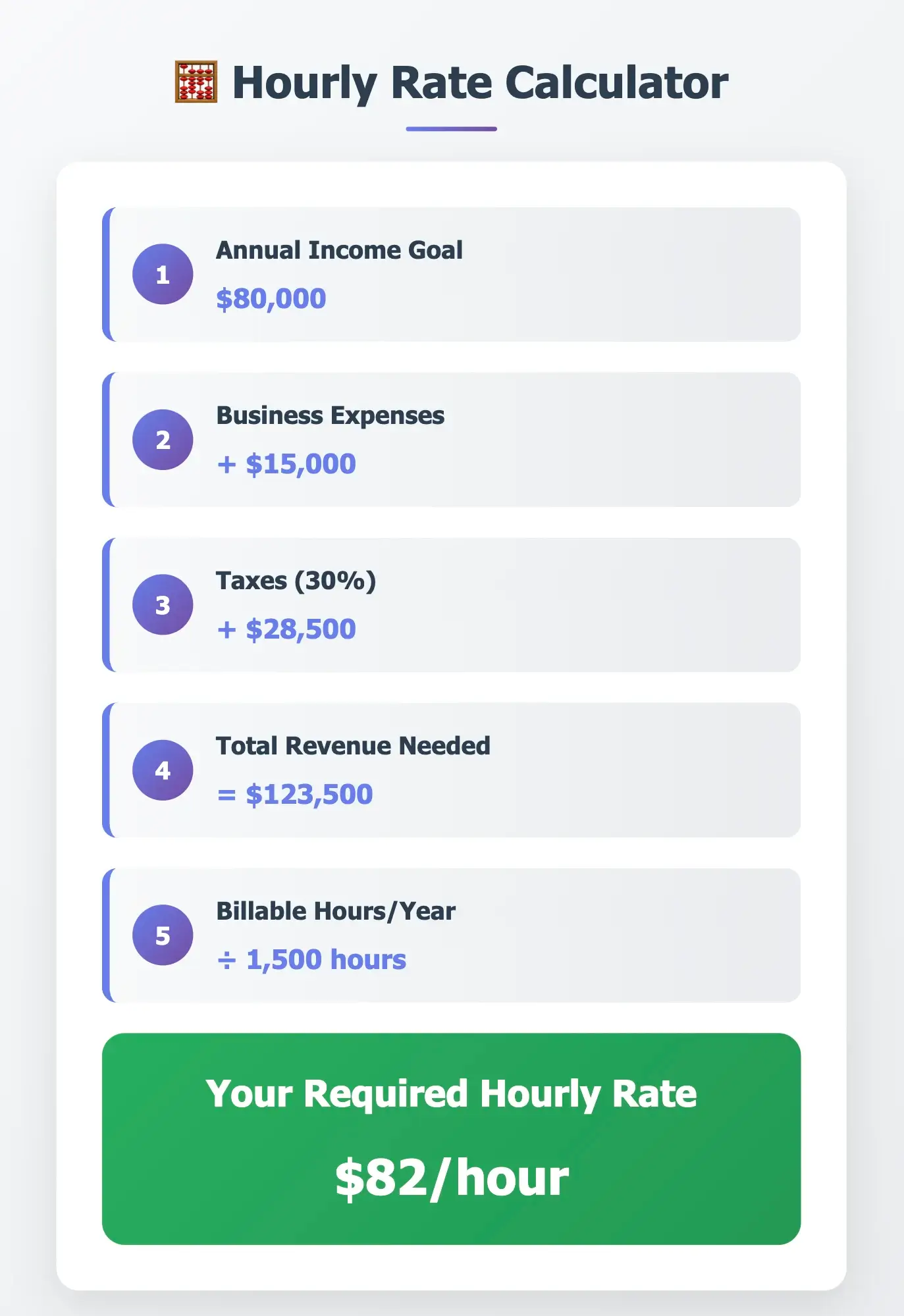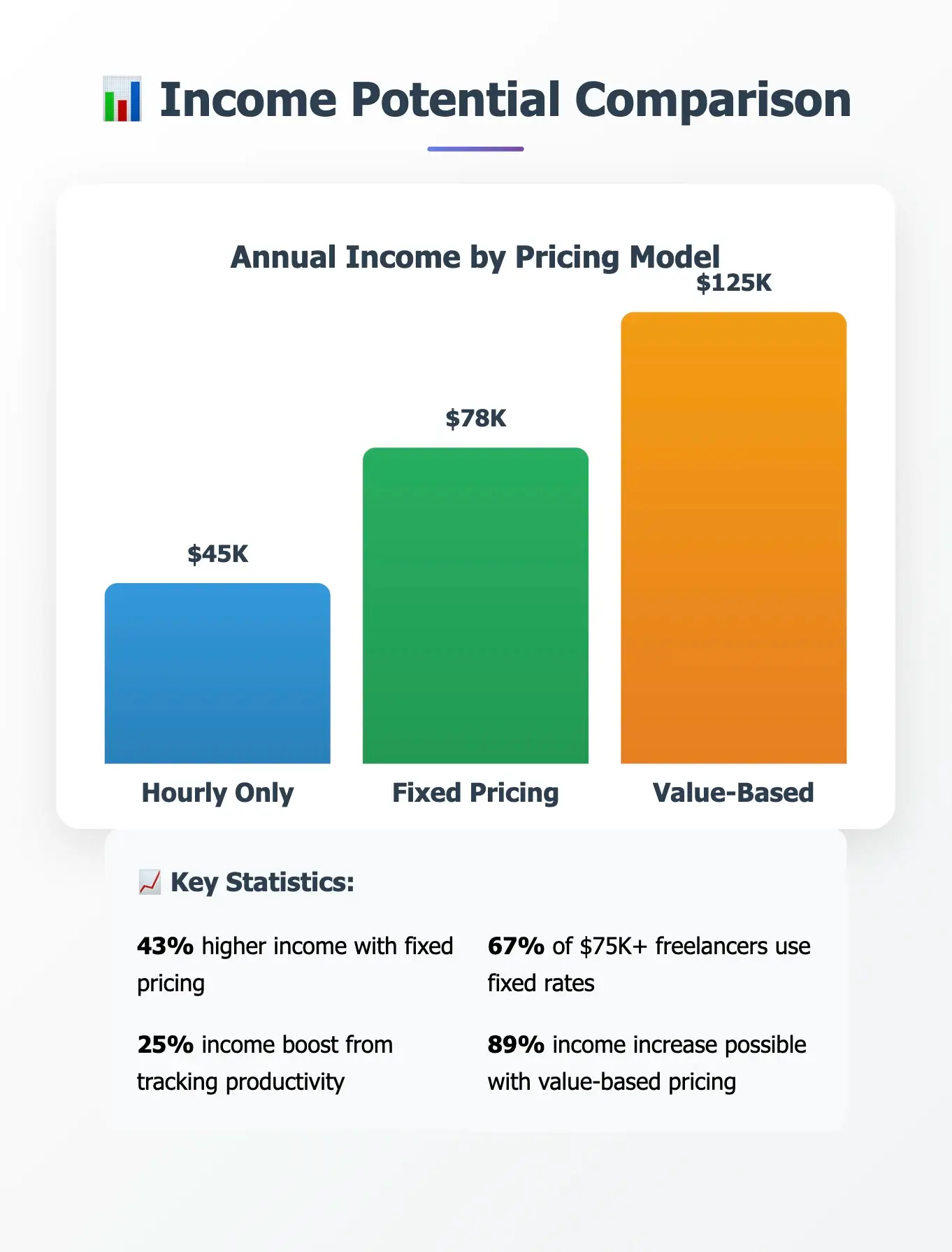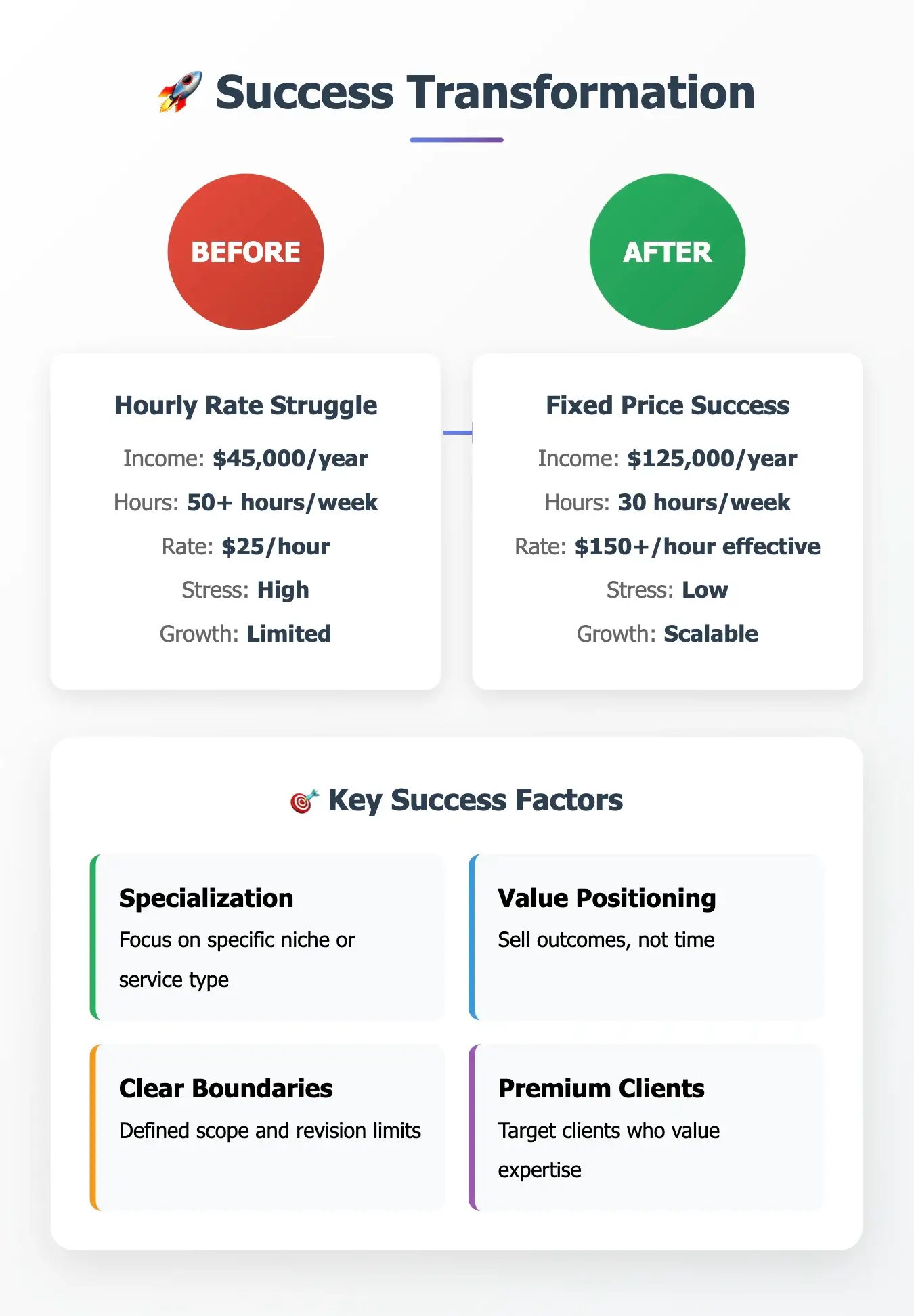Calculating Your Freelance Rates: Use This Powerful Pricing Calculator

Introduction
Using a freelance pricing calculator can make or break your income. Have you ever wondered why some freelancers earn 3x more than others with similar skills? The answer often lies not in what they do, but in how to price freelance work using smart tools like hourly rates, fixed fees, or value-based pricing models.
👉 For a complete overview of freelance income models and how to scale them effectively, read our Value-Based Pricing Strategy: How to Set the Right Price Based on Perceived Value.
Most freelancers struggle with the fundamental question: should I charge hourly or offer fixed project pricing? This isn’t just a tactical decision-it’s a strategic choice that influences your business model, positioning, client experience, and long-term income trajectory.
In this comprehensive freelance pricing guide, we’ll break down both pricing models, share real-world examples, and help you choose the optimal approach for growing your freelance business in 2025.
Freelance Pricing Calculator: Hourly vs Fixed Rates Explained
Hourly Rate Pricing
Freelance hourly rate pricing is one of the most common approaches, where you charge clients for each hour you work on their project. It’s straightforward: if you charge $50 per hour and work 20 hours, you earn $1,000.
Example: A freelance writer charges $40/hour for blog content. A 2,000-word article takes 4 hours to complete, resulting in $160 total payment.
Fixed Rate Pricing (Project-Based)
Freelance project pricing is another approach where you charge a predetermined amount for the entire project, regardless of time spent. In this model, you’re essentially selling the outcome, not your time.
Example: A web designer charges $3,000 for a complete website redesign, whether it takes 30 hours or 60 hours to complete.
The Core Difference
- Hourly rates = You’re selling your time
- Fixed pricing = You’re selling your expertise and results
This fundamental distinction affects everything from client perception to your earning potential.
Freelance Rate Comparison: Hourly vs Project Pricing Models
| Criteria | Hourly Rates ⏰ | Fixed Pricing 💰 |
|---|---|---|
| Income Predictability | Variable (depends on hours worked) | Predictable (set project amount) |
| Scalability | Limited (only 24 hours per day) | High (can sell expertise, not time) |
| Risk Level | Low (paid for every hour) | Higher (if project scope expands) |
| Client Perception | “Service provider” | “Expert consultant” |
| Administrative Work | High (time tracking required) | Low (simple project invoicing) |
| Earning Potential | Capped by available hours | Unlimited (based on value delivered) |
| Suitable for Beginners | Yes (easier to estimate) | Requires experience to price accurately |
Visual Summary: Hourly vs Fixed Pricing at a Glance

When to Choose Hourly Rates
Understanding how to price freelance work starts with knowing when hourly billing works best in scenarios where time investment is unpredictable or ongoing.
Ideal Situations for Hourly Rates:
1. Unclear Project Scope: When clients can’t define exactly what they need, hourly rates protect you from scope creep. Consulting projects often fall into this category.
2. Long-term Maintenance Work: Ongoing website updates, social media management, or technical support are perfect for hourly billing.
3. Beginning Freelancers: If you’re new to freelancing and still learning how to price freelance work, hourly rates provide a reliable safety net.
4. Research-Heavy Projects: Market research, data analysis, or investigative work where time requirements vary significantly.
Real Example:
Sarah, a freelance marketing consultant, charges $75/hour for strategy sessions. Since each client’s needs vary dramatically, she can’t predict whether a project will take 5 hours or 25 hours. Hourly billing ensures she’s compensated fairly for complex problem-solving.
↑ Back to Table of ContentsWhen to Choose Fixed Pricing
This approach becomes powerful when you can deliver consistent results efficiently and want to scale your income beyond time constraints.
Ideal Situations for Fixed Pricing:
1. Clearly Defined Deliverables Logo design, website development, or e-book writing have specific end results that clients can evaluate.
2. Repeatable Processes When you’ve streamlined your workflow and can complete similar projects faster than competitors.
3. High-Value Expertise How much should freelancers charge often depends on clients being willing to pay premium prices for specialized knowledge, not just time spent.
4. Package Services Bundling multiple services works especially well with fixed pricing as part of your overall approach.
Real Example:
Marcus, a freelance web developer, initially charged $60/hour but switched to fixed pricing after gaining experience. He now charges $4,500 for e-commerce websites. Even if he completes them in 40 hours (equivalent to $112.50/hour), clients pay for the expertise and result, not just time.
↑ Back to Table of ContentsHow to Use a Freelance Pricing Calculator and Billable Hours to Set the Right Rate
Hourly Rate Calculation Formula
Step 1: Determine your annual income goal
Step 2: Calculate your billable hours per year
Step 3: Add business expenses and taxes
Formula:
Hourly Rate = (Annual Income Goal + Business Expenses + Taxes) ÷ Billable Hours
Example Calculation:

Fixed Pricing Calculation Method
1. Estimate Time Required Based on similar past projects, calculate expected hours.
2. Research Market Rates Check competitor pricing and industry standards.
3. Add Value-Based Premium Consider the client’s potential ROI from your work.
4. Include Buffer for Revisions Add 20-30% buffer for unexpected changes.
Formula:
Fixed Price = (Estimated Hours × Hourly Rate) + Value Premium + Buffer
Example:
- Estimated time: 30 hours
- Your hourly rate equivalent: $75
- Base price: $2,250
- Value premium: $750
- Buffer (25%): $750
- Final fixed price: $3,750
Real-World Success Stories: Complete Transformations
Case Study #1: The Designer’s Strategic Pivot
Anna, Graphic Designer – From Time-Seller to Brand Expert
The Starting Point: Anna worked 45+ hours per week charging $35/hour for various design tasks. She felt trapped in a cycle of endless revisions and scope creep. Clients saw her as “the designer who makes things pretty” rather than a strategic partner.
Monthly breakdown:
- Billable hours: 160/month
- Gross income: $5,600
- After expenses and taxes: ~$3,500
- Stress level: Maximum
The Transformation Process:
Phase 1: Positioning Shift (Months 1-2) As part of refining her approach to setting freelance rates, Anna stopped accepting random design tasks and focused exclusively on brand identity projects. She studied her most successful projects and identified patterns in client success.
Phase 2: Package Development (Months 3-4) As part of her new freelance pricing packages approach, she created three strategic packages:
- Brand Foundation: $1,200 (logo + basic guidelines)
- Brand Identity System: $2,800 (complete visual identity)
- Brand Launch Package: $4,500 (identity + marketing materials)
Phase 3: Value Communication (Months 5–6)
As part of refining her pricing approach, Anna stopped saying “I’ll design your logo” and started positioning herself with statements like: “I’ll create a brand identity that increases customer recognition and trust, potentially boosting revenue by 15–25%.”
The Results After 12 Months:
- Monthly income: $12,000-$18,000
- Work hours: 25-30 per week
- Client quality: Premium businesses with bigger budgets
- Stress level: Significantly reduced
- Waiting list: 6-8 weeks for new projects
Key Success Factors:
- Client Education: Anna created a “Brand ROI Calculator” showing clients potential revenue impact
- Process Systematization: Developed repeatable workflows that reduced project time by 40%
- Premium Positioning: Raised minimum project value from $500 to $1,200
Anna’s Advice: “I wish I’d understood earlier that clients don’t buy hours—they buy transformation. Once I aligned my approach to focus on business growth instead of design time, everything changed.”
Case Study #2: The Developer’s Technical Evolution
James, Web Developer – From Code Monkey to Business Consultant
The Challenge: James was skilled technically but struggled with implementing effective pricing approaches. He charged $45/hour and constantly competed with offshore developers charging $15/hour. Despite excellent technical skills, his lack of clear pricing strategy left him feeling undervalued and overworked.
The Analysis Phase: James tracked his work for 90 days and discovered:
- 60% of time spent on similar e-commerce builds
- Clients valued business results over technical complexity
- His solutions typically increased client revenue by $10,000-$50,000 annually
The Strategic Overhaul:
As part of redefining his approach to pricing, James implemented a complete strategic overhaul to reposition his services and increase perceived value.
Specialization Decision: As part of refining his pricing approach, James focused exclusively on e-commerce websites for local service businesses (restaurants, gyms, salons) earning $500K-$2M annually.
Value-Based Pricing Structure:
- Starter E-commerce: $4,500 (basic online store)
- Growth E-commerce: $8,500 (advanced features + marketing integration)
- Premium E-commerce: $15,000 (custom solutions + ongoing optimization)
Results After 18 Months:
- Annual income: $180,000+ (vs. previous $72,000)
- Project completion time: 50% faster due to templates
- Client retention: 85% for ongoing maintenance contracts
- Referral rate: 60% of new business from referrals
The Game-Changing Insight: James realized he wasn’t selling websites—he was selling “digital revenue systems.” This shift in language and positioning was directly tied to his pricing approach and allowed him to charge premium prices.
Stories like James’s show how powerful strategic positioning and value-based pricing can be. If you’re ready to follow a proven path to consistent $10K months, read our step-by-step guide on How to Scale Your Freelance Business.
Case Study #3: The Photographer’s Creative Breakthrough
Maria, Wedding Photographer – From Hourly Hustle to Premium Packages
Industry Context: Photography is notoriously difficult for pricing because clients often think: “It’s just pressing a button, right?” Before adjusting her approach, Maria charged $75/hour and struggled with clients questioning every expense.
The Original Model:
One of the most typical approaches she used was charging $75/hour plus editing time.
- Average wedding: 8 hours shooting + 12 hours editing = $1,500
- Monthly income: $6,000-$8,000 (working weekends constantly)
- Problem: Clients nickel-and-dimed every hour
The Transformation Strategy:
Phase 1: Value Research (Month 1) Maria surveyed 50 past clients about their wedding priorities and discovered:
- 89% valued “capturing moments they missed” most highly
- 76% wanted “stress-free experience” over cost savings
- 92% would pay more for “peace of mind”
Phase 2: Package Restructuring (Months 2-3) This shift was a key upgrade in her approach, replacing hourly billing with experience-based packages:
Essential Story Package – $3,200
- Full wedding day coverage (unlimited hours)
- 200+ edited photos
- Online gallery for sharing
- Engagement session included
Complete Experience Package – $5,800
- Everything in Essential
- Second photographer
- Same-day preview (10 photos within 2 hours)
- Premium album design
- Rehearsal dinner coverage
Legacy Collection Package – $9,500
- Everything in Complete Experience
- Videographer coordination
- Custom wedding website
- Day-of timeline management
- Post-wedding “trash the dress” session
Phase 3: Positioning as Experience Designer (Months 4-6) Maria stopped calling herself a “wedding photographer” and started positioning as a “wedding story designer.” Her marketing emphasized emotional outcomes over technical specs, aligning perfectly with her updated pricing approach.
Breakthrough Results (After 12 Months):
- Average project value: $5,200 (vs. previous $1,500)
- Booking rate: 85% of consultations (vs. 45% previously)
- Work-life balance: Weekends protected, no more 20-hour editing marathons
- Client quality: Premium couples who valued artistry over price
- Annual income: $156,000 (previously $72,000)
The Critical Success Elements:
- Eliminated Time Discussion: Never mentioned hours in sales conversations
- Emotional Positioning: Sold “preserving once-in-a-lifetime moments” not photos
- All-Inclusive Pricing: No surprises or add-on fees that create friction
- Experience Focus: Positioned herself as part of the wedding team, not just a vendor
Maria’s Reflection: “The moment I stopped selling ‘time with a camera’ and started selling ‘peace of mind that your story will be beautifully preserved,’ my pricing approach — and my entire business — completely transformed. Clients stopped questioning her prices because her approach clearly communicated the value they would receive.”
Industry-Specific Lessons for Other Creatives:
- Videographers: Sell “legacy preservation” not “footage editing”
- Writers: Sell “audience engagement” not “word creation”
- Designers: Sell “brand transformation” not “visual creation”
- Consultants: Sell “business growth” not “advice delivery”
Case Study #4: The Architect’s Precision Strategy
David, Freelance Architectural Designer – From Drafting Service to Design Authority
Industry Background: Architecture traditionally uses hourly billing due to project complexity and regulatory requirements. David initially followed this model but eventually realized his pricing approach needed to account for creative exploration and revision cycles without constant justification.
The Starting Challenge:
- Rate: $85/hour for residential design projects
- Average project: 60-120 hours over 4-6 months
- Client friction: Constant questioning of time allocations
- Income volatility: Feast or famine based on project cycles
- Creative limitation: Clients rushed creative process to minimize hours
The Strategic Analysis: David analyzed 24 months of project data and discovered:
- 70% of his projects were custom home renovations ($200K-$800K budgets)
- His design-focused approach often resulted in property value increases of $50K to $150K, proving the ROI of his expertise.
- Clients valued design innovation over time efficiency
- Premium clients cared more about results than process costs
The Restructuring Approach:
Phase 1: Value Quantification (Months 1-2) David researched property value impacts of good design:
- Well-designed renovations: 15-25% property value increase
- Poor design choices: 5-10% value decrease vs. potential
- His portfolio showed average 18% property value improvement
Phase 2: Package Development (Months 3-4)
Residential Design Packages:
Design Consultation Package – $2,500
- Site analysis and feasibility study
- Preliminary design concepts (3 options)
- Budget and timeline estimates
- Permit requirement assessment
Complete Design Package – $12,500
- Everything in Consultation
- Detailed architectural drawings
- 3D renderings and walkthroughs
- Construction document preparation
- Two rounds of revisions included
Full-Service Design Package – $22,500
- Everything in Complete Design
- Contractor coordination and vetting
- Construction administration
- Material and finish specifications
- Project management through completion
Phase 3: Expertise Positioning (Months 5-6) David repositioned from “architectural drafter” to “residential design strategist.” His proposals emphasized ROI, lifestyle improvement, and long-term property value.
Transformation Results (18 Months Later):
Financial Metrics:
- Average project value: $15,800 (vs. previous $7,000)
- Project completion time: 25% faster due to streamlined process
- Annual income: $189,000 (vs. previous $102,000)
- Client satisfaction: 94% completion rate (vs. 78% previously)
Business Quality Improvements:
- Premium clientele: Attracted clients with $400K+ renovation budgets
- Reduced scope creep: Fixed packages eliminated endless revisions
- Creative freedom: Clients trusted his expertise instead of micromanaging time
- Referral network: 65% of new business from architect and contractor referrals
The Critical Pivot Points:
- Value Framing: Positioned design investment as property value enhancement
- Process Confidence: Fixed pricing forced him to optimize workflow efficiency
- Expertise Premium: Charged for knowledge and problem-solving, not just drawing time
- Client Education: Taught prospects about design ROI before discussing price
David’s Key Insight: “Architecture clients don’t want to buy hours of my time—they want confidence that their investment will create the home of their dreams while maximizing property value. Once I packaged that confidence instead of selling time, clients stopped questioning costs and started trusting recommendations.”
Cross-Industry Applications:
- Engineers: Sell “optimized solutions” not “calculation time”
- Lawyers: Sell “legal protection” not “research hours”
- Accountants: Sell “financial optimization” not “number crunching”
- Consultants: Sell “business transformation” instead of “meeting time”
Common Pricing Mistakes and How to Avoid Them
Hourly Rate Mistakes
❌ Mistake #1: Setting Rates Too Low Many freelancers forget to account for business expenses, taxes, and non-billable time.
✅ Solution: Use the hourly rate formula above and include ALL business costs.
❌ Mistake #2: Not Tracking Time Accurately Underestimating actual work time leads to unpaid hours.
✅ Solution: Use time-tracking tools like Toggl or RescueTime from day one.
❌ Mistake #3: Billing for Learning Time New freelancers often feel guilty charging for research or skill development.
✅ Solution: Build learning time into your rates—clients benefit from your improved expertise.
Another overlooked factor is your professional setup. High-quality tools and software don’t just boost productivity — they elevate the results you deliver.
Fixed Pricing Mistakes
❌ Mistake #1: Unclear Project Scope Vague project descriptions lead to scope creep and unpaid work.
✅ Solution: Create detailed project proposals with specific deliverables and revision limits.
❌ Mistake #2: Underestimating Project Complexity Inexperienced freelancers often quote too low for complex projects.
✅ Solution: Always add 25-50% buffer time to your estimates until you have extensive experience.
❌ Mistake #3: Not Collecting Deposits Starting work without upfront payment creates cash flow problems.
✅ Solution: Require 50% deposit before starting any fixed-price project.
↑ Back to Table of ContentsFreelance Income Potential: Hourly vs Fixed vs Value-Based
Not all pricing models are created equal. This comparison shows how much more freelancers can earn by switching from hourly billing to fixed and value-based pricing.

Advanced Freelance Pricing Strategies for Higher Profit
Choosing the right pricing model is just one piece of the puzzle. To truly future-proof your income, explore 10 proven ways to diversify your freelance revenue in 2025 — from productized services to affiliate income and scalable offers.
The Hybrid Approach: Maximum Flexibility with Protected Boundaries
The most sophisticated freelancers don’t choose between hourly and fixed pricing—they strategically combine both to maximize income while protecting their interests.
Before we dive into hybrid models, it’s worth stepping back and using a freelance pricing calculator to clarify your income targets and pricing tiers. Our Value-Based Pricing Strategy: How to Set the Right Price Based on Perceived Value breaks down scalable income paths, value-based models, and how to combine them for consistent growth.
Strategic Hybrid Structure:
Core Project: Fixed Pricing
- Main deliverable with clearly defined scope
- Protects against scope creep
- Allows for efficient workflow optimization
- Positions you as an expert, not a service provider
Additional Services: Hourly Rates
- Revisions beyond agreed scope (typically 2-3 rounds included)
- Rush delivery requests (premium hourly rate: 1.5-2x normal rate)
- Client training or consultation calls
- Technical support after project completion
Real Implementation Example: Jessica, a copywriter, charges $3,500 for a complete website copy package (fixed price including up to 3 revision rounds). Additional revisions cost $95/hour. Rush delivery within 48 hours costs $150/hour for all work time. This structure earned her $127,000 last year while maintaining clear boundaries.
Advanced Hybrid Variations:
- The Premium Rush Model
- Standard fixed price for normal timeline
- 25% premium for 2-week delivery
- 50% premium for 1-week delivery
- 100% premium for 48-hour delivery
- The Expertise Tier System
- Junior-level work: Fixed pricing with competitive rates
- Senior-level work: Fixed pricing with premium rates
- Expert consultation: High hourly rates ($150-$300/hour)
Retainer Models: The Holy Grail of Freelance Income
Retainers provide the stability of employment with the freedom of freelancing. They’re particularly powerful for freelancers who’ve proven their value to clients.
Retainer Structure Types:
1. Hours-Based Retainer
- Client pays for guaranteed availability
- Unused hours typically don’t roll over
- Predictable income for both parties
Example: $4,000/month for 25 hours of work, additional hours at $180/hour
2. Value-Based Retainer
- Payment for ongoing strategic support
- Less focus on specific hour tracking
- Higher rates due to strategic value
Example: $6,000/month for ongoing marketing strategy and execution support
3. Hybrid Retainer
- Base retainer for availability
- Project bonuses for specific deliverables
- Performance bonuses tied to client results
Case Study: The Retainer Transformation
Michael, a digital marketing consultant, transitioned three hourly clients to retainer agreements:
Before Retainers:
- Client A: $85/hour, 15 hours/month average = $1,275/month (variable)
- Client B: $90/hour, 12 hours/month average = $1,080/month (variable)
- Client C: $95/hour, 18 hours/month average = $1,710/month (variable)
- Total monthly income: $4,065 (highly variable)
After Retainer Transition:
- Client A: $2,500/month retainer (20% increase for guaranteed availability)
- Client B: $2,200/month retainer (similar reasoning)
- Client C: $3,000/month retainer (premium for strategic advisory role)
- Total monthly income: $7,700 (predictable)
Benefits Achieved:
- 89% income increase
- Predictable cash flow for business planning
- Stronger client relationships through ongoing partnership
- Reduced sales and marketing time (retained clients vs. constant prospecting)
Value-Based Pricing for Freelancers: The Ultimate Strategy
Value-based pricing for freelancers represents the highest evolution of freelance pricing strategy. Instead of charging for time or effort, you charge based on the economic value you create for clients. Once you start earning more through value-based pricing, it’s crucial to make those gains work for you long-term. Check out our guide on Smart Investment Strategies for Freelancers to turn high-value income into sustainable passive streams.
The Value-Based Pricing Framework:
Step 1: Value Discovery
During client consultations, ask specific questions:
- “What would solving this problem be worth to your business?”
- “What’s the cost of not addressing this issue?”
- “How will success be measured financially?”
- “What’s your budget range for this type of business investment?”
Step 2: Value Quantification
Translate client answers into concrete numbers:
- Revenue increases
- Cost savings
- Risk mitigation value
- Time savings (converted to dollar value)
- Competitive advantages
Step 3: Value-Based Pricing Calculation
Price as a percentage of value created, typically 10-30% depending on:
- Certainty of outcomes
- Your track record
- Client’s risk tolerance
- Market competitive factors
Advanced Value-Based Examples:
Email Marketing Specialist:
- Situation: E-commerce client doing $100K/month revenue
- Problem: 2% email conversion rate (industry standard: 4%)
- Solution: Email optimization increasing conversions to 4.5%
- Value Created: Additional $125K annual revenue
- Value-Based Price: $25,000-$37,500 (20-30% of first-year value)
- Time Investment: 40 hours of work
- Effective Rate: $625-$937/hour
SEO Consultant:
- Situation: Local service business getting 50 leads/month online
- Problem: Ranking on page 2-3 for key terms
- Solution: SEO optimization achieving page 1 rankings
- Value Created: Increase to 150 leads/month, 30% conversion rate = 30 additional customers/month
- Client Revenue per Customer: $2,000 lifetime value
- Annual Value Created: $720,000 in additional revenue
- Value-Based Price: $72,000-$144,000 (10-20% of annual value)
Clearly, the right service in the right niche can unlock massive earning potential.
If you’re exploring which niches offer the best ROI opportunities, check out the Top 5 Most Profitable Freelancing Niches in 2025 — complete with real-world case studies like this one.
Critical Success Factors for Value-Based Pricing:
- Track Record: You need proven results to justify value-based pricing
- Industry Knowledge: Deep understanding of client’s business model and metrics
- Confidence: Ability to have high-level business conversations about ROI
- Risk Management: Clear success metrics and performance guarantees
- Communication Skills: Ability to articulate value proposition clearly
Dynamic Pricing Strategies
Seasonal Pricing Adjustments
Adjust rates based on demand cycles:
- Peak season: 25-50% premium pricing
- Off-season: Standard rates with value-added services
- Holiday periods: Premium rush rates
Market Position Pricing
- Penetration Pricing: Lower rates to enter new markets, with planned increases
- Premium Positioning: Consistently high rates to signal expertise and quality
- Competitive Pricing: Market-rate pricing with superior service differentiation
Client Tier Pricing
- Startup/Small Business: Standard rates with package deals
- Mid-Market Companies: Premium rates with comprehensive service
- Enterprise Clients: Highest rates with white-glove service and account management
Psychology of Premium Pricing
The Authority Principle
Higher prices often signal higher quality and expertise. Clients subconsciously associate cost with value, especially in professional services.
Anchoring Effect
Always present your highest-priced option first. This makes your standard pricing seem more reasonable by comparison.
Package Psychology
Three-tier pricing structures (Good/Better/Best) typically drive 60-70% of clients to choose the middle option, optimizing revenue while providing client choice.
Scarcity and Urgency
Limited availability (only taking 3 new clients this quarter) or time-sensitive pricing (this quote expires in 7 days) can justify premium pricing and accelerate decision-making.
Expert Insights on Freelance Pricing
According to the 2024 Freelancing in America Study, freelancers who use project-based pricing earn 43% more than those who rely solely on hourly rates. The study found that experienced freelancers increasingly move toward value-based pricing as they develop expertise.
Key findings:
- 67% of high-earning freelancers ($75K+) use fixed or project-based pricing
- Only 31% of new freelancers feel confident setting fixed prices
- Freelancers who track their hourly productivity earn 25% more regardless of pricing model
Industry expert Brennan Dunn, author of “Double Your Freelancing Rate,” emphasizes: “The biggest mistake freelancers make is selling their time instead of selling outcomes. Clients don’t care how long something takes—they care about results.”
↑ Back to Table of ContentsTools and Resources for Better Pricing
Time Tracking Tools (for Hourly Work)
- Toggl Track – Simple, intuitive time tracking
- Harvest – Time tracking with invoicing integration
- RescueTime – Automatic productivity tracking
Project Management Tools
- Asana – Free project organization
- Monday.com – Visual project workflows
- ClickUp – All-in-one workspace
Invoicing and Payment
- FreshBooks – Professional invoicing for freelancers
- Wave – Free accounting software
- Stripe – Online payment processing
Pricing Research
- Glassdoor – Salary and rate comparisons
- Upwork – Market rate research
- FreelancerMap – Industry rate surveys
Creating Your Pricing Strategy: Step-by-Step Action Plan
Phase 1: Assessment (Week 1)
- Analyze your current situation
- Use a freelance pricing calculator to determine how your past projects align with your ideal hourly or project-based rates.
- Review client feedback and results delivered
- Identify your most profitable project types
- Research your market
- Study competitor pricing on platforms and websites
- Survey past clients about budget expectations
- Join freelancer communities for rate discussions
Phase 2: Testing (Weeks 2-4)
- A/B test both approaches
- Quote some projects hourly, others fixed
- Track time invested vs. payment received
- Monitor client satisfaction levels
- Gather data
- Which pricing model attracts better clients?
- Where do you feel more confident?
- Which generates higher income per hour?
Phase 3: Implementation (Week 5+)
- Choose your primary model
- Based on data from testing phase
- Consider your business goals and lifestyle preferences
- Plan transition strategy for existing clients
- Optimize and refine
- Adjust rates based on market feedback
- Develop pricing packages or tiers
- Create clear pricing communication materials
FAQ: Freelance Pricing Guide
Q: Should new freelancers start with hourly or fixed pricing?
A: New freelancers should typically start with hourly rates. This approach provides safety while you learn to estimate project scope and build confidence. Once you’ve completed 10-15 similar projects, you’ll have enough data to quote fixed prices accurately.
Q: How often should I raise my freelance rates?
A: Review and potentially increase rates every 6-12 months, or after completing major skill upgrades. Successful freelancers typically raise rates by 10-25% annually. The key is to increase rates for new clients first, then gradually transition existing clients.
Q: What if a client prefers hourly rates but I want to charge fixed prices?
A: Offer both options with strategic pricing. Quote your fixed price, then show the hourly equivalent at a higher rate. For example: “This project is $3,000 fixed, or $125/hour if you prefer hourly billing.” Most clients will choose the fixed option when they see the potential hourly cost.
Q: How do I handle scope creep with fixed pricing?
A: Prevention is key. Create detailed project scopes with specific deliverables, revision limits, and change request procedures. Include language in contracts like: “Additional requests beyond the agreed scope will be billed at $X/hour” or require approval for scope changes before proceeding.
Q: Can I combine hourly and fixed pricing for the same client?
A: Absolutely! Many successful freelancers use hybrid models. For example, charge a fixed rate for the main project deliverable, but use hourly billing for additional revisions, training, or ongoing support. This provides clarity for core work while protecting against scope expansion.
Q: How can I make sure my rates reflect my business costs and income goals?
A: Use a freelance pricing calculator regularly to update your rates based on changes in your expenses, goals, or market conditions. It helps you stay profitable while remaining competitive.
↑ Back to Table of ContentsFrom Struggling Freelancer to Scalable Success: What Changes Everything
Real success often comes down to shifting your pricing strategy and how you position your work. Here’s a clear example of what can happen when you move from hourly billing to fixed vs hourly freelance pricing with the right foundations in place.

Conclusion: Choose Your Path to Higher Freelance Income
The choice between hourly rates and fixed pricing isn’t just about personal preference – it’s a strategic decision that shapes your earning potential, positioning, and long-term growth. Hourly rates are great for gaining traction, while fixed pricing and value-based models allow you to scale, productize, and earn more per client.
Key Takeaways:
- Start hourly if you’re new—gain clarity, data, and experience.
- Switch to fixed or value-based pricing when your process is repeatable and results-driven.
- Combine models where appropriate: fixed for deliverables, hourly for extras.
- Pricing isn’t static—it’s a business skill you refine continuously.
Your Next Steps:
- Use a freelance rate calculator to define your baseline.
- Test fixed vs hourly pricing on 2–3 upcoming projects.
- Measure client feedback, actual time spent, and total income.
- Choose your primary pricing model based on results, not assumptions.
💡 Freelancers don’t get paid for hours—they get paid for outcomes. Price accordingly.
↑ Back to Table of Contents
Want to Go Deeper? Explore More From the Freelance Income & Monetization Hub:
🎯 Focus: Income growth, pricing, scaling, and passive revenue strategies
- Smart Investment Strategies for Freelancers — Turn freelance income into long-term wealth.
- How to Diversify Your Freelance Income in 2025 — 10 proven ways to build multiple revenue streams.
- How to Scale Your Freelance Business to $10K/Month — A tactical blueprint for consistent growth.
- The Top 5 Most Profitable Freelancing Niches in 2025 — Where demand, pricing power, and ROI intersect.
🧱 Pillar Article:
- 🧭 Value-Based Pricing Strategy: How to Set the Right Price Based on Perceived Value – The master guide for setting your pricing, diversifying income, and scaling strategically.
Want more daily strategies?
Join our FreelanceBoosters Telegram channel for practical tips, pricing insights, and tools to grow your freelance business in 2025 and beyond.



